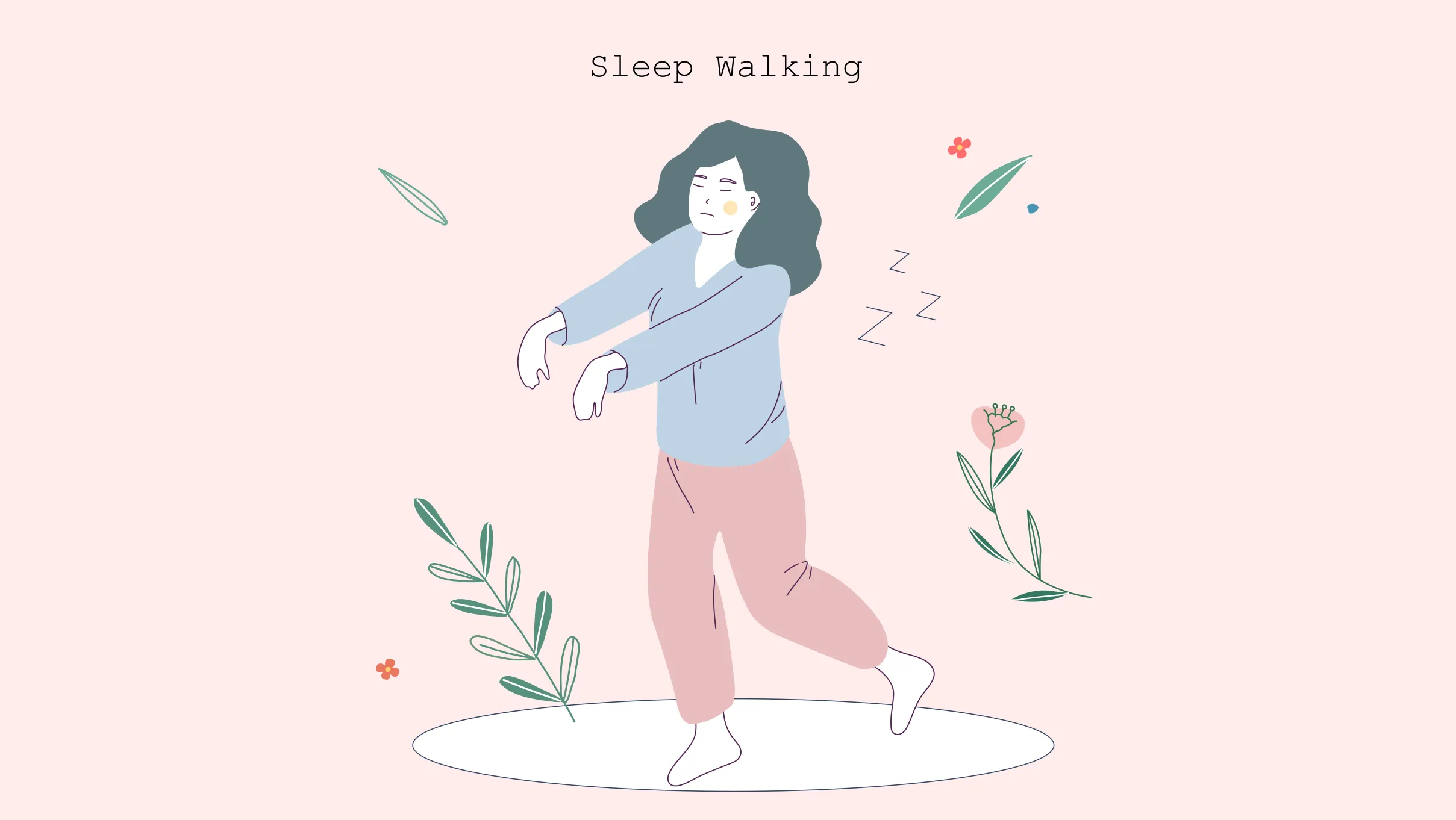Sleepwalking – Symptoms and causes
Written by


Also known as Somnambulism, sleepwalking is a condition in which you get up and start walking around while asleep. This condition is more common in children than adults, and usually, children outgrow them by the time they enter their teens. This can be a symptom of an underlying sleep disorder, and medical intervention becomes necessary. Today, we are here to tell you all you need to know about sleepwalking, from its symptoms to its causes. Read on!
Sleepwalking: What is Somnambulism?
How does sleepwalking work? People sleepwalking get up and walk around or do other activities while still asleep. They won’t remember getting up or engaging in activities during the sleepwalking phase. It usually occurs in the first half of the sleep cycle, within an hour or two of falling asleep.
What Are the Causes of Sleepwalking?
Let’s take a look at what causes sleepwalking.
1. Genetics and family history
Sleepwalking is hereditary, and the condition may run in families. So, if any of your parents or grandparents suffered from this disorder, you are at risk too.
2. Sleep deprivation
If you don’t get enough sleep continuously, you are more vulnerable to sleepwalking. In one study, the MRI scans of people with a history of sleepwalking showed that sleep deprivation increased their frequency of sleepwalking.
3. Some medications
Few medicines, such as antidepressants or beta-blockers, when used regularly, can induce sleepwalking.
4. Alcohol
High doses of alcohol increase the quality of slow-wave sleep and can trigger sleepwalking.
5. Brain injury
Traumatic brain injury leads to parasomnias, which include sleep terrors, sleepwalking, and rapid eye movement sleep disorders.
6. Fever
Fevers, primarily in children, are associated with sleepwalking. It can even lead to night terrors and other sleep disturbances too.
7. Obstructive sleep apnea (OSA)
According to research, almost 10% of people suffering from OSA show parasomnia symptoms, including hallucinations, sleepwalking, and sleep eating.
8. Restless Leg Syndrome (RLS)
Some scientists don’t see an association between RLS and sleeping. However, according to some studies, it is seen that the medications used in RLS can be the reason behind sleepwalking.
9. Stress
While stress and anxiety interfere with a good night’s rest, they can also lead to sleepwalking in adults. In one study, it was found that daytime stress could trigger sleepwalking.
10. Noises or touches or going to bed with a full bladder
The brain activates this ‘wake-up disorder’ when triggered by certain stimuli like loud noise or a full bladder.
11. Changes in the sleep environment
Some people may experience sleepwalking when there is a change in their sleep environment, like sleeping in a hotel.
12. Migraines
According to research, if you have been suffering from frequent headaches and migraines, it can put you at risk of sleepwalking.
Is Sleepwalking Harmful?
Sleepwalking in itself may not be harmful. But it can be dangerous because people sleepwalking are unaware of their surroundings and may not realize what they are doing. Also, according to a study, it can induce violent behaviour and impact your health adversely. Sleepwalkers also experience disturbed sleep and hence experience excessive daytime sleepiness and fatigue.
Symptoms of Sleepwalking
In adults and kids, somnambulism occurs during the night’s first half, an hour or two after falling asleep. Usually, an episode of sleepwalking can last for a few minutes, and also longer. The common sleepwalking symptoms are;
- They get up and walk around
- May experience sleep terrors along with sleepwalking
- May experience daytime sleepiness and fatigue
- May sit and open their eyes in bed while still asleep
- They may have a glazed expression
- Sleepwalkers may not remember the sleepwalking episodes in the morning
- They find it difficult to wake up during a sleepwalking episode
Someone sleepwalking may also;
- Do everyday activities, like getting dressed, eating or talking
- Leave the house or drive a vehicle
- May engage in unusual behaviour, such as urinating in the cupboard
- They may engage in sexual activities without awareness
- Get injured
- Show violence
How to Treat Sleepwalking?
Usually, treatment isn’t required for sleepwalking in children. However, your doctor might offer suitable treatment options if it is posing a threat or they are displaying violent behaviours.
- Sometimes, sleepwalking can occur due to an underlying medical condition. So, once the condition is treated, sleepwalking stops.
- If the sleepwalking results from a specific medication, your doctor will alter the drugs prescribed.
- Anticipatory awakening may be used. Here, the person who is sleepwalking is woken up approximately 15 minutes before they start sleepwalking, and they stay awake for a few minutes before going back to bed.
- Self-hypnosis, therapy, counselling, and medications are other treatment options available.
What Should I Do if My Child Sleepwalks?
If you notice your child sleepwalking, ensure you don’t startle them. Gently guide them back to bed. You can also take other precautionary measures, such as;
- Lock the doors and windows so that your child doesn’t wander outside
- Make sure you avoid bunkbeds to ensure they don’t fall from their beds.
- Keep sharp and dangerous objects out of their reach.
- Install safety gates outside your child’s room and any stairs.
When to See a doctor?
Treatment is usually not required for sleepwalking unless;
- The sleepwalking episodes are regular
- They cause excessive daytime sleepiness
- It causes violent behaviour
- Starts as the first time in adults
Conclusion
Sleepwalking is a sleep disruption that leads you to wake up and do normal activities when asleep. While it is not a dangerous disorder, it can sometimes lead to violent behaviour or injuries, and here, medical intervention becomes necessary.
FAQs
What triggers sleepwalking in adults?
The exact reason is still unknown, but it can be a hereditary condition.
What happens during a sleepwalk?
During a sleepwalking episode, a person may walk around or do normal activities. However, they may look slightly confused once they wake up.
How do I stop sleepwalking?
If sleepwalking is a regular occurrence, you must consult your doctor for the right treatment plan.
What are the dangers of sleepwalking?
Aforementioned, some of the dangers of sleepwalking can include self-injury and violent behaviour.
people like this article
Written by






